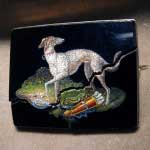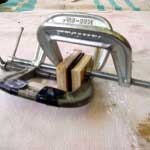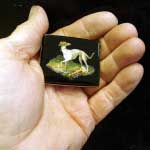Micro mosaics like these were done in the 18th and 19th centuries by the same workshops in Rome that meticulously copied all the paintings in the central nave of St. Peter’s, and replaced them so that the originals could be kept in a humidity controlled, incense-free environment. It was even noted, at the time, that the atmosphere inside the huge volume created by the enormous dome, had its own weather – and sometimes even created clouds that would hover in the cathedral. There were, as well, great clouds released from the burning of frankincense, which, like tobacco smoke, over time leaves a resinous coating on the walls and objects in the room. It was because of this that a pope in the mid-18th century decided to remove the glorious paintings and to have them replaced with undetectable micro mosaic copies. The craftsmen assembled for the job developed the necessary techniques, and libraries of square glass “tesserae” in a range of 1700 shades of color. This allowed recreations of the mostly Renaissance masterpieces to be made with their full range of subtle color and chiaroscuro.
After their work was finished – for it was a finite job – these craftsmen found themselves highly skilled but without commissions, and so they began making beautiful tables and wall-plaques for the Italian nobility. They made scenes from Classical literature, minutely and intricately portrayed, and set them in backgrounds of black marble. These scenes at first appear to be painted, but close examination reveals them to be made up from countless thousands of individually chosen (mostly) rectangular pieces of colored glass, set into a backing. The tesserae are set so carefully that one can hardly see the spaces between them, and images are developed that are surprisingly crisp and detailed.
Later on these craftsmen began making brooches and necklaces, and the tesserae became almost microscopic. Their clientele had now enlarged to include British tourists on the famous “Grand Tour” which always included a month in Rome – and visiting a set of Roman ruins that are now commonly found on micro mosaic brooches and tables of the period – the Colosseum, the Roman Forum, St. Peter’s Basilica, and so on.
This micro mosaic of a greyhound is set in a black glass surround. For some reason this glass is unstable, and commonly cracks. This is, of course, a threat to the whole mosaic, and they quickly begin to lose individual tesserae along the length of the cracks that run in the glass underneath.
The first, conservational step on these cracked pieces is to seal the cracks and every tesseract in the mosaic with an optical epoxy that seeps in and stabilizes the whole. At that time the whole mosaic also needs to be flattened back to its original plane, which process can be seen in photo #2.
We then make the cracks in the black glass surround disappear by washing off the actual mosaic, coating the cracks locally with optical epoxy, sanding this area smooth, then airbrushing the black, and a coating that can be sanded and polished to match the original. A similar process can be done with the edges and the back. The dog itself needed a few tesserae to be replaced with color matched epoxy, and some re-grouting of the colored wax that came to be used between the tesserae.
The entire panel measures about 2” across, and was finally reset with its gold-washed silver brooch-mount.







